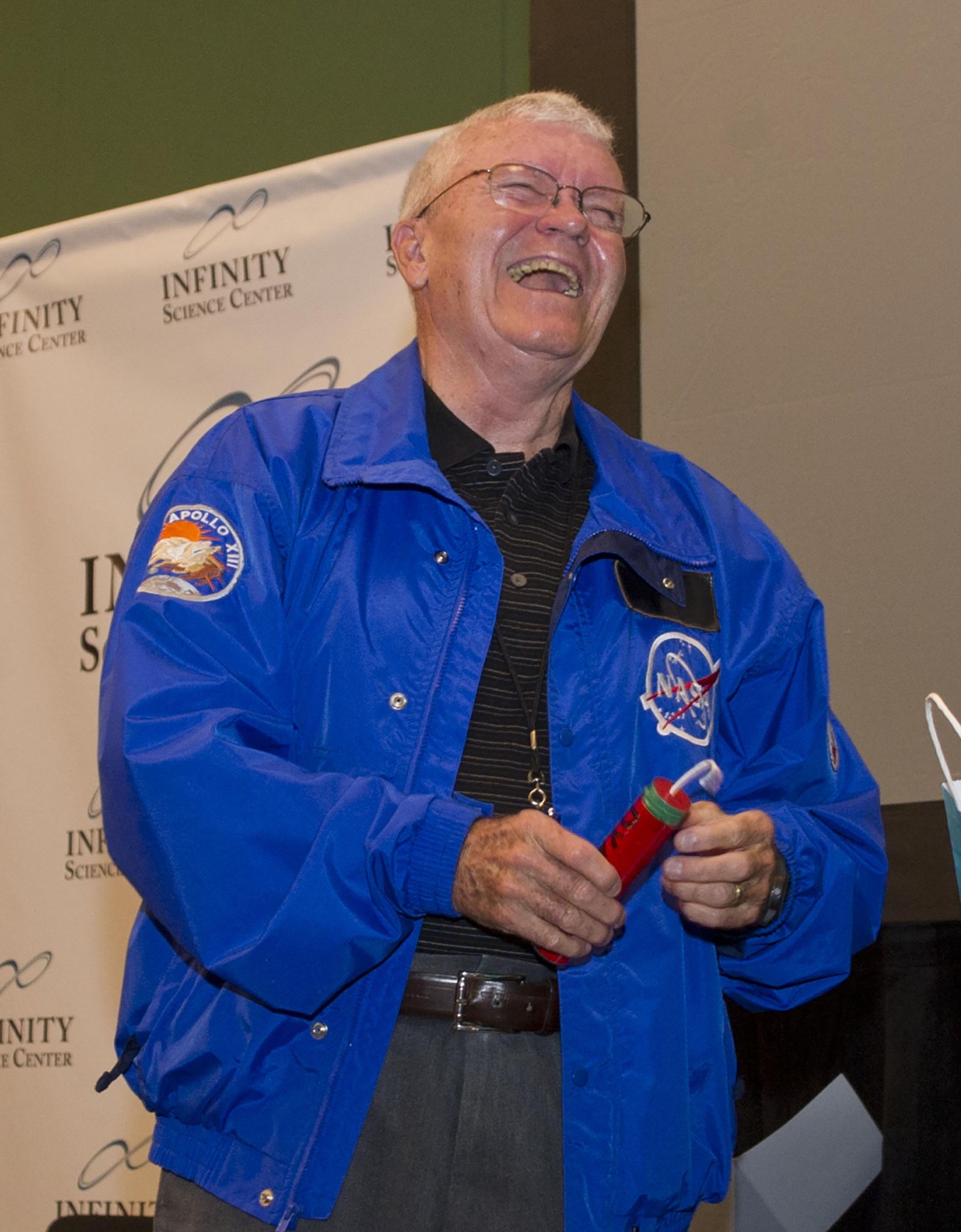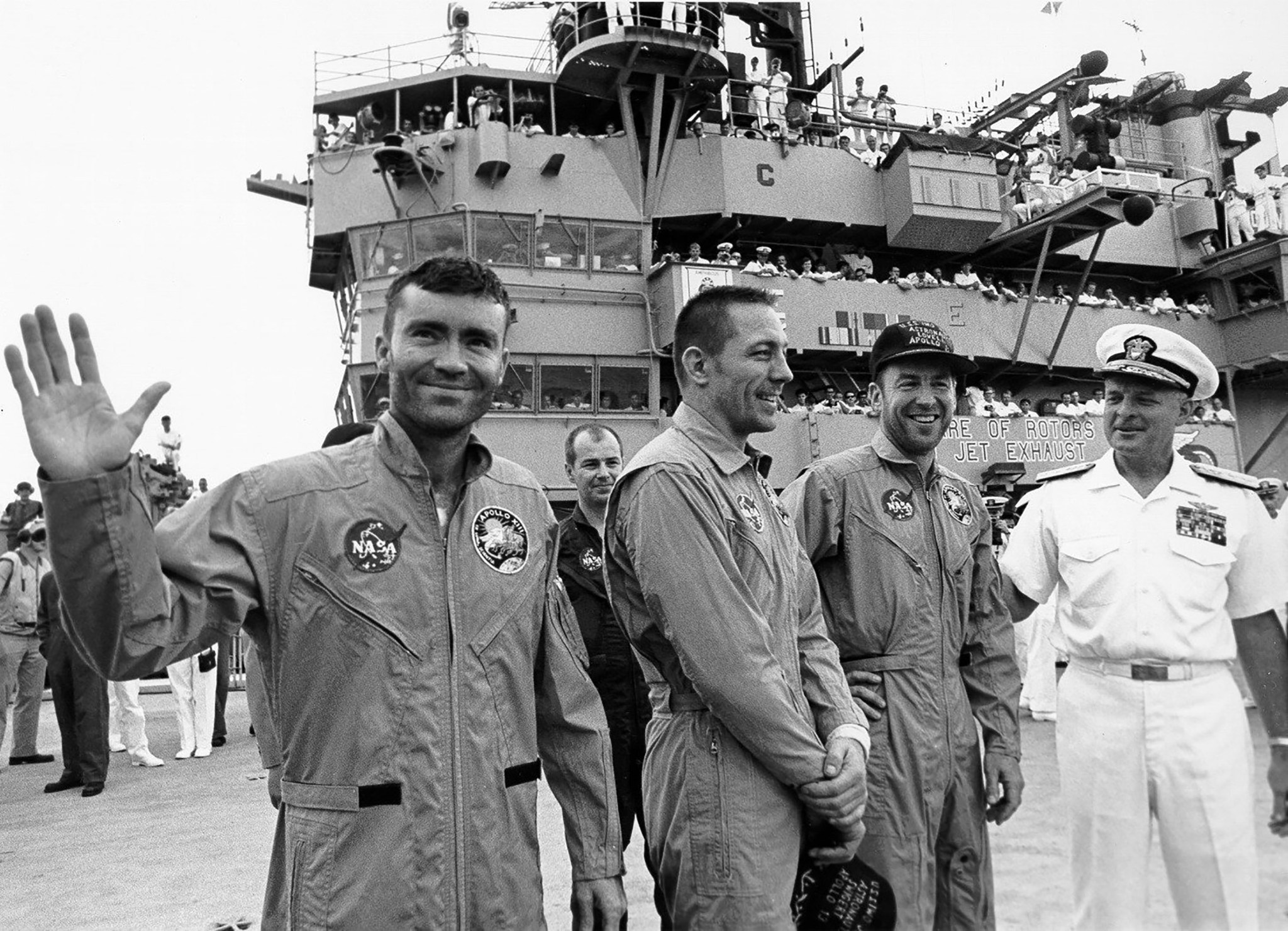Fred Haise laughs like someone who has discovered the secret – that every day is a gift to be enjoyed. It is not even necessary to hear him laugh to realize this. Just seeing a photo of him in full-face delight is enough.
He has seen behind the curtain. He knows the joy of being alive. At 87 years old, it is more than just the fact that he has enjoyed a full life. One easily could say Haise has enjoyed multiple lives – as a fighter pilot, research pilot, celebrated astronaut, aerospace executive and, eventually, inspirational paragon.
He wears the lives comfortably, like the retired victor moving in the ease of his own experiences and remembrances, a sentiment Haise likely would decline to consider. He is an engineer after all, mainly given to analyzing, calculating and reasoning instead of speculation and hypotheticals.
Then – you hear him laugh.
Fred Wallace Haise Jr. was born in the Mississippi coastal town of Biloxi in November 1933. At the time, the city boasted little more than 15,000 residents, before the mini-population boom that would come with the arrival of World War II and Keesler Air Force Base.
Haise attended local schools – Gorenflo Elementary School and Biloxi High School. He completed high school two years early and headed to Perkinston Junior (now Mississippi Gulf Coast Community) College to study journalism. “My initial interest in journalism developed through work on the Biloxi High School newspaper as sports editor, followed by two years at Perkinston as sport editor and editor of the Bulldog Barks,” he said.
That training was interrupted by the Korean War and Haise’s interest in serving his country. “My father advised me to become a commissioned officer if I joined the military,” he said. “The only program that fit, being 18 years old with only two years of college, was the Naval Aviation Cadet Program that led to becoming a naval aviator.”
Haise had never even flown on a plane. Nevertheless, he enlisted in the program. “Almost from my first flight, I knew that I loved flying,” he said. “That led me to a career in aviation and space.”
After training, Haise served as a U.S. Marine Corps fighter pilot until 1956. In the ensuing decade, he earned a bachelor’s degree in aeronautical engineering from the University of Oklahoma, served in the Oklahoma Air National Guard, was recalled to U.S. Air Force service during the Berlin Crisis, graduated as the most outstanding student in Class 64A at the Aerospace Pilot School at Edwards Air Force Base and flew as a research pilot at NASA’s Lewis (now Glenn) Research Center, as well as a civilian research pilot at NASA’s Flight Research Center at Edwards.
The experiences gave Haise the chance to fly multiple aircraft. Through his life, he would accumulate more than 9,000 hours of flying time, including more than 6,000 in jets.
All of that flying did not lead immediately to an interest in space. “I was certainly aware of the Mercury Program and even got to meet some of the original seven astronauts when they came to Lewis for training,” he recalled. “At that time, it was not clear there would be anyone flying into space beyond Mercury. It wasn’t until the announcement by President Kennedy of going to the Moon and the emergence of the Gemini and Apollo Programs that I became interested in joining the space program.”
Haise was one of 5,000 to apply as a member of NASA’s Astronaut Group 5. After testing, medical examinations and selection panel interviews, he emerged as the highest-scoring applicant of all and was one of 19 astronaut candidates chosen.
After training, Haise served as a backup crew member on the Apollo 8 mission, the first to travel around the Moon. He was scheduled as a member of the Apollo 11 crew with Neil Armstrong and Buzz Aldrin. However, Michael Collins had been withdrawn from an earlier mission because of illness and was shuffled down to Apollo 11 following his recovery, moving Haise to backup.
The chance to fly to space finally came with Apollo 13, accompanying commander Jim Lovell and command module pilot Ken Mattingly. However, the mission would launch with backup command module pilot Jack Swigert replacing Mattingly, who has been exposed to the measles.
The flight proceeded as expected until an oxygen tank 56 hours in created a crisis that would hold the world spellbound for the next four days. Haise was in the lunar module at the time of the incident. When he made it to his command module seat, he saw oxygen tank No. 2 was gone. “The strongest emotion for me was right after the explosion when I first surveyed the instrument panel and confirmed that we had lost oxygen tank No. 2,” he said. “I knew without referring to he mission rules that this called for an abort (of the lunar landing). I was sick of my stomach with disappointment, realizing that all the training I had done to fly Apollo 8, 11 and 13 was wasted.”
Despite the well-documented drama to follow, Haise said he was never concerned about a return to Earth. “I never felt that we would not have a chance to attempt a reentry,” he said. “The environment was wearing (however), as we had to live in a damp, mid 30-degree crew cabin for four days without adequate clothing.”
During their trip around the Moon and back to Earth, the crew had to perform a number of emergency procedures. “The training on my prior missions only came into play where the procedures were the same for Apollo 13,” Haise noted. “Most of our workarounds for Apollo 13 were unique. Real-time workarounds developed by Mission Control and contractors saved the day.”
General aviation experience helped the astronauts most, Haise explained. “I think the general ability to deal with the unexpected or with handling failures goes back to my aviation experience over the years from 1953,” he said. “I have been on fire several times, once receiving burns over 65 percent and spending three months in a hospital. I have had experience with engine failures and other more minor system failures over the years.”
As the spacecraft circled the dark side of the Moon, Haise and Swigert peered out the windows for their first close look at the lunar surface. “One of the two things that was unique with my spaceflight experience were the views out the window, both from low-Earth orbit, as well during the passage to and from the Moon and, in particular, our brief look at the backside from an altitude of a little over 130 miles,” Haise said. “I was impressed with how much more rugged the backside looked without any of the large dark areas (mares) seen on the front side from Earth.”
After circling the Moon, Haise was able to glimpse the Fra Mauro region where he and Lovell had been scheduled to land. One could wonder at the emotions he felt, but Haise recalled, “I did not feel any added disappointment as I viewed the area.”
He takes the same view when asked to glean lessons from the experience. “I don’t think there were any new lessons from Apollo 13 (compared to other missions) as to the importance of training or being prepared and having teamwork to work through unplanned circumstances,” he said. “All missions had to deal with problems. In fact, both Apollo 14 and 16 almost aborted their landings.”
Haise remained with NASA for nine years after Apollo 13. He served on the backup crew for Apollo 16 and was scheduled to command the Apollo 19 mission, until it was canceled. He subsequently commanded three of five free flight test missions for the Space Shuttle Program, demonstrating the aerodynamic design and landing capability of the new vehicle. He was scheduled to fly a shuttle mission, but it became clear rollout of the new vehicle would be delayed. Haise subsequently left NASA in 1979 to work as a Grumman Aerospace Corp. executive, retiring in 1996.
The Biloxi native was inducted into the U.S. Astronaut Hall of Fame in 1997. In December 2009, NASA presented Haise with the agency’s Ambassador of Exploration Award, a recognition of his role as a spokesperson for space. Haise presented the encased Moon rock he received to his former elementary school for display to students.
Haise has remained a staunch supporter of Stennis Space Center, which he first visited as a rookie astronaut. He also has been a tireless advocate for INFINITY Science Center, the official visitors center for Stennis. “I think aviation, space and science museums are important for the knowledge imparted to young and old,” he said. “For the young, it is possible the interesting things they see and learn about will inspire them to make the most of the talent with which they are blessed.
“INFINITY also serves as a beacon along the highway into Mississippi to encourage people to visit and stay awhile,” he continued. “It gives them a view of the incredible work being done at Stennis Space Center. Through the hands-on exhibits and special programs, education is provided to many visiting young people.”
INFINITY visitors can learn about Haise as well. His Apollo 13 flight suit is on view. The Apollo 19 booster stage that would have launched him to the Moon also is located there, clearly seen by vehicles leaving Louisiana to enter Mississippi.
Decades removed, Haise no longer lives on the Gulf Coast. However, there is no doubt he still resides in the area, bigger than life for all to know.
There is one photo of Haise and his Apollo 13 crewmates that commands attention. Following splashdown, they had been delivered to the nearby USS Iwo Jima. They are being greeted by U.S. Navy Rear Adm. Donald C. Davis, commander of Recovery Task Force. Ship crew members are everywhere to catch a glimpse.
Lovell is nearest the admiral, flanked by Swigert, both with full smiles. Haise is at the foreground end of the line, looking to his right, his hand raised in greeting to welcoming sailors. A small smile plays on his face and in his eyes.
One can just tell – he knows a secret.
Lacy Thompson
Stennis Space Center, Bay St. Louis, Mississippi
228-688-3749
calvin.l.thompson@nasa.gov































